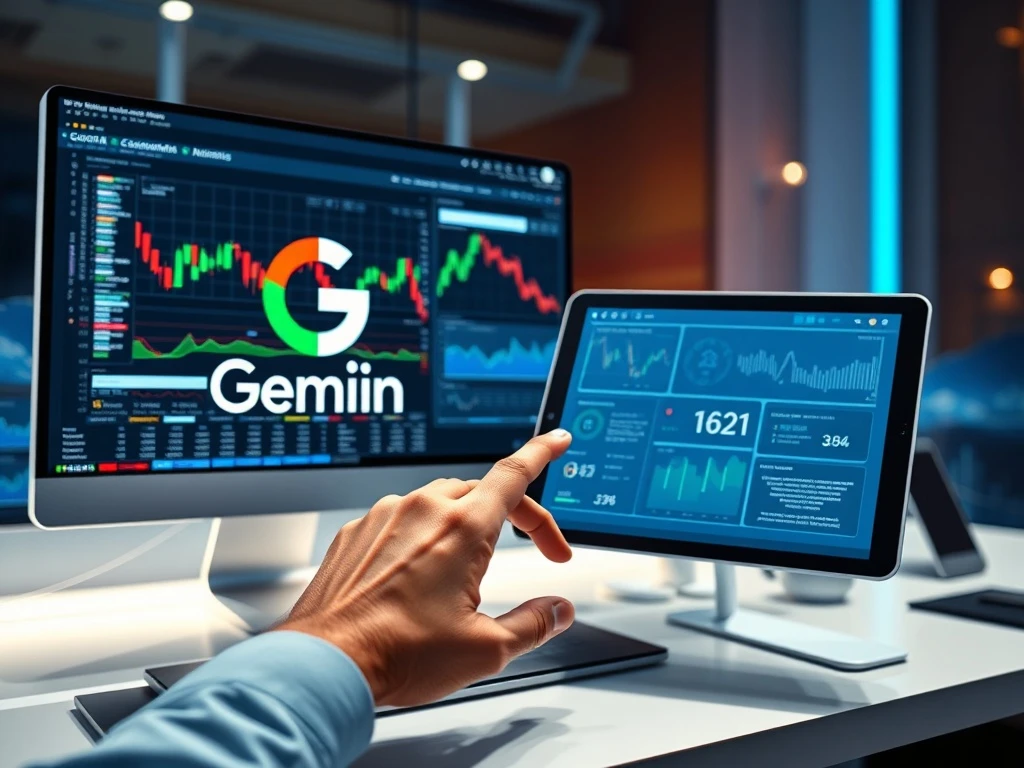Master Day Trade Crypto: Unlock Powerful Strategies with Google Gemini AI

Day trading crypto presents both immense opportunities and significant challenges. The fast-paced, 24/7 nature of cryptocurrency markets often overwhelms even experienced traders. However, a new powerful tool is emerging to help: Google Gemini AI. This advanced artificial intelligence offers day traders innovative ways to filter market noise, effectively manage risk, and act on market catalysts with greater confidence. This article explores how to integrate Google Gemini AI into your daily workflow, transforming your approach to day trade crypto without ever handing over your private keys.
Understanding Day Trade Crypto and its Challenges
Day trading in crypto means opening and closing positions within the same trading day. Often, these trades conclude within hours or even minutes. Unlike swing traders who ride trends for days, or long-term investors holding for months, day traders thrive on short-term price movements. Volatility is their primary playground, and crypto markets offer it in overdrive. This intensity presents several unique challenges:
- 24/7 Markets: There is no closing bell. Bitcoin (BTC) can break out at any hour.
- Narrative-Driven Pumps: A token upgrade or a social media post can instantly shift sentiment.
- Liquidity Pockets: Order books can thin out quickly, leading to significant slippage on unplanned entries.
- Noise Overload: Telegram, X, Discord, on-chain alerts, and macro news all compete for attention, generating hundreds of signals.
This is precisely where AI tools, such as Google Gemini AI, become invaluable. They do not replace the trader; instead, they act as a co-pilot. They assist by summarizing order flow and sentiment, filtering critical catalysts from background noise, structuring data into clear sheets or dashboards, and helping you write, test, and refine trading rules instead of chasing FOMO.
Google Gemini AI: Capabilities for Crypto Trading Strategies
Google Gemini AI offers significant capabilities for enhancing your crypto trading strategies. It serves as a powerful tool for researching strategies. However, it cannot directly execute trades. It effectively summarizes fundamentals and compares assets, thereby supporting daily trade decisions. Yet, it still requires access to external data sets for comprehensive analysis. Gemini AI also helps manage trading discipline by turning watchlists, catalysts, and post-mortems into structured loops, which prevents traders from reacting to mere noise.
What Gemini Can Do Well:
- Reason Over Large Context: Newer Gemini releases, like Gemini 2.5 Pro, excel at long-context reasoning and strong coding ability. This makes it ideal for stitching together market data and your personal notes into actionable summaries.
- Live Inside Your Tools: Gemini integrates across Google Workspace apps, including Docs and Sheets. Here, it can summarize data, clean it, and generate charts. It even offers in-cell AI functions within Sheets for enhanced data manipulation.
- Developer-Friendly: With Google AI Studio and the Gemini API, you can programmatically prompt models. This allows for data set analysis and integration of outputs into custom scripts or dashboards.
What Gemini Should Not Do (Directly):
It is crucial to keep Gemini focused on analysis, signal generation, backtesting, and alerts. Do not allow it to hold crypto keys or auto-trade unsupervised. If you connect to an exchange API, strictly gate its permissions. Notably, Google’s Gemini can process up to 1 million tokens in a single prompt. This means traders can feed entire research reports, news flows, and charts into one query for faster insights.
Setting Up Your Workspace for AI in Crypto Trading
To effectively leverage AI in crypto trading, setting up a structured workspace is the next logical step. First, select your Gemini access level. Options include Google AI Studio with an API key for developers building prompts and scripts, or Gemini in Workspace (Docs/Sheets) for no-code research and dashboards. Google now bundles “Advanced” features under the Google AI Pro subscription for the Gemini app. This offers bigger context windows and deeper research capabilities. For maximum context across multi-asset intraday notes, this subscription can be very helpful.
Creating a Trading Notebook in Google Sheets
Once you choose your Gemini access, create a trading notebook. This structured space helps AI organize market chaos into clarity. A simple Google Sheet with six tabs can serve as an excellent starting point:
- Watchlist: Track the tokens you are monitoring.
- Catalysts: Note key events, such as upgrades, unlocks, or macro reports.
- Levels: Mark out support, resistance, and liquidity pockets.
- Order Flow: Capture on-chain flows, funding rates, or order book imbalances.
- Plan: Write your playbook before the trading session begins.
- Post-Mortem: Log what worked, what failed, and what to improve.
This approach moves you from scanning endless tabs to a repeatable loop: Watchlist → Catalysts → Levels → Plan → Order Flow → Post-Mortem → back to Watchlist. Gemini integrates into each step as a reasoning partner. While you can manually create data sets, another effective method is to use data sets downloaded from analytics providers like Glassnode, TradingView, or CryptoQuant. A 2025 global survey by IOSCO reported that among broker-dealers, algorithmic trading (63%) was a common AI use case, alongside market analysis/trading insights (40%).
Practical Examples: How to Day Trade Crypto Using Gemini AI
Integrating Gemini AI into your daily day trade crypto routine can streamline analysis and decision-making. Here are several practical examples:
Refining Your Watchlist with Gemini AI
Imagine your watchlist includes Bitcoin (BTC), Cardano (ADA), and Solana (SOL). Instead of manually scanning dozens of tokens, you can ask Gemini to highlight those with the biggest market swings or highest percentage changes in the past 24 hours. You would feed it your own data or data from an external platform. A prompt might be: “Summarize the top three coins by 24-hour price change from this data set. Rank them by potential risk of shorting.” Gemini will provide context and a structured ranking. This helps you focus your limited time on the most volatile assets based on the data you provided.
Filtering Market Catalysts Effectively
Catalysts drive intraday moves. These include Consumer Price Index reports, US Federal Reserve minutes, token unlocks, tech upgrades, or even airdrop rumors. However, there is often more noise than signal. Instead of manually scrolling through X or Discord, paste in relevant headlines. Then, ask Gemini AI: “Flag which of these news catalysts are most likely to impact ETH and SOL in the next 12 hours, based on past price reactions.” This significantly reduces noise and highlights actionable information.
Mapping Key Levels and Liquidity
Support and resistance levels are fundamental to day trading. While Gemini cannot stream live order books, you can feed it recent OHLCV (open, high, low, close, and volume) data or your own notes. Then, ask: “Identify the key price clusters where ETH was rejected multiple times this week and summarize as possible resistance.” Instead of eyeballing charts, you receive a clear text summary. For example: “ETH repeatedly rejected near $3,950-$4,000; prior support at $3,840 flipped resistance.”
Analyzing Order Flow Sentiment
If you track open interest, long/short ratios, or whale wallet flows, Gemini AI can help make sense of this complex data. You might prompt: “Summarize whether current BTC futures positioning looks more skewed to longs or shorts.” You still need the raw BTC data downloaded from your trading portals. However, Gemini AI’s summary helps you avoid tunnel vision. Instead of just staring at numbers, you get an interpreted snapshot, telling you if the crowd leans long, short, or neutral.
Developing a Daily Trading Plan
The Plan tab is where Gemini helps enforce trading discipline. A prompt like: “Take today’s Watchlist, Catalysts, and Levels tabs and draft three possible intraday scenarios with triggers and invalidations.” This might yield an output such as:
- Scenario A: Ether (ETH) breaks above $3,000 on high volume; long scalp with stop at $2,960.
- Scenario B: BTC rejects $105,000 resistance again and fades into $100,000.
- Scenario C: SOL reacts negatively to unlock event; short bounce into $170.
Now, you possess a structured plan instead of simply winging it.
Conducting Post-Mortem Reviews
After your trading session, paste your trades into Gemini AI. Ask: “Analyze my last five trades and identify patterns in mistakes or strengths.” It might reveal that you consistently cut winners too early but let losers run. Alternatively, it could highlight that you always overtrade during high volatility. This process transforms mistakes into structured lessons for continuous improvement.
How Google Gemini AI Helps Manage Crypto Risk
Risk is the most critical variable every day trader must control. Surviving bad trades often matters more than catching perfect ones. Use Google Gemini AI for a vital discipline check to manage crypto risk effectively:
- Position Sizing: Share your account size and maximum risk per trade. Gemini AI can then calculate safe position sizes under different leverage scenarios.
- Scenario Planning: Instead of only mapping bullish setups, prompt Gemini AI to outline bearish and sideways cases. This ensures you are never locked into a single bias.
- Risk-to-Reward Ratios: Paste your planned setups into Gemini. Ask it to rank them by their “r/r” ratio. This keeps your focus squarely on the highest-quality trades.
- Capital Allocation: Ask Gemini to summarize your exposure across assets. For example, it can identify if you have too much ETH beta. This allows you to rebalance your portfolio before it is too late.
Day trading crypto will always remain a high-speed, high-risk game. Google Gemini AI does not offer shortcuts. Instead, it provides the ability to process more information, adhere to your trading rules, and refine strategies significantly faster than you could alone. This article does not contain investment advice or recommendations. Every investment and trading move involves risk, and readers should conduct their own research when making a decision.








